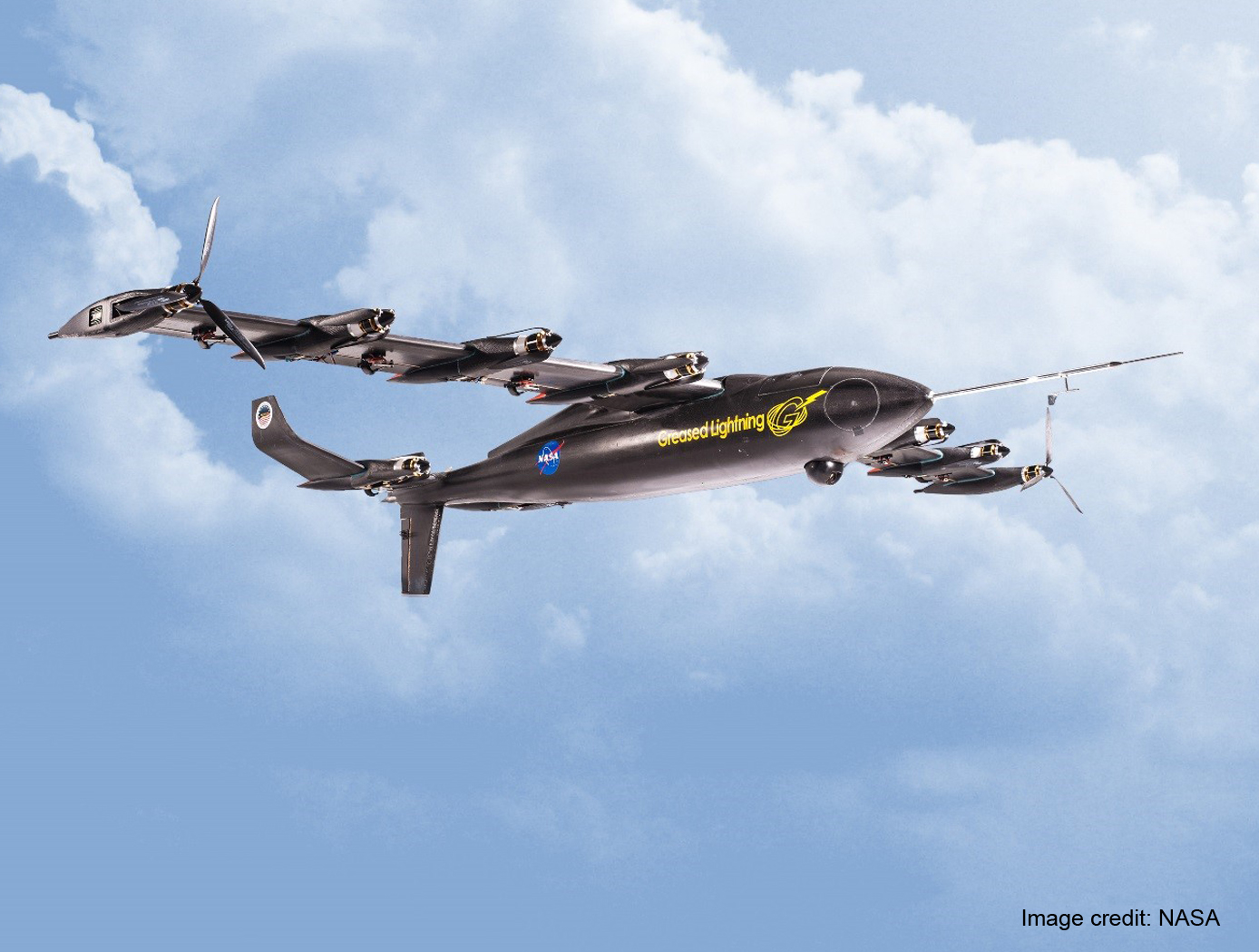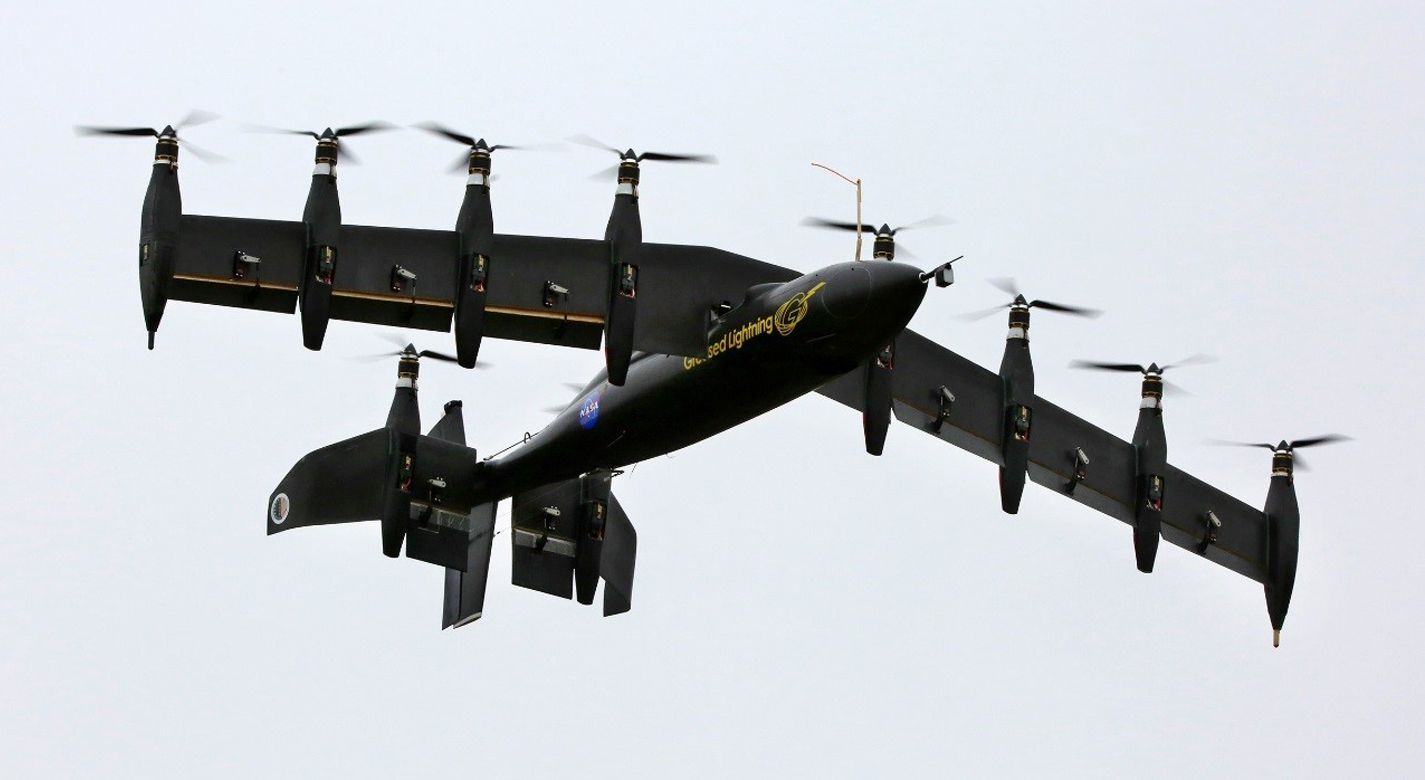VTOL UAV With the Cruise Efficiency of a Conventional Fixed Wing UAV
Aerospace
VTOL UAV With the Cruise Efficiency of a Conventional Fixed Wing UAV (LAR-TOPS-241)
A novel UAV design that enables vertical take-off and landing (VTOL) capability with long endurance flight
Overview
NASA Langley Research Center has developed Greased Lightning, the first UAV that combines vertical take-off and landing (VTOL) capability with long endurance flight. Previously these two capabilities have been considered mutually exclusive. For example, helicopters offer VTOL capability, yet are inefficient for long-endurance travel. The UAV market is large (multi-billion USD) and growing, with a global reach and many regional markets. This presents numerous opportunities and entry points for a new and superior UAV technology.
The Technology
The core technology that enables the Greased Lightning UAV is the aerodynamic efficiency it achieves in its cruise configuration. Electric motors at each propeller negate the need for drive shafts and gearing which enables this Distributed Electric Propulsion (DEP) aircraft configuration. The design is intended to utilize a hybrid electric drive system that includes small diesel engines which drive alternators to power the electric motors and to charge an on-board battery system. The batteries provide the power boost needed for VTOL and hovering. Numerous other novel design elements are incorporated, such as folding propellers to minimize drag when not in operation, such that the propulsive efficiency can be nearly ideal at both hover and wing borne flight conditions.


Benefits
- Combines vertical take-off and landing (VTOL) capability with long endurance flight enabled by the aerodynamic efficiency of the design
- Minimal takeoff/landing site requirements
Applications
- Surveillance (optical, IR, SAR, and other sensor payloads)
- Live event coverage
- Large area field surveys
- Industrial inspections
|
Related Links:
|
Similar Results

Aircraft Vertical Takeoff & Landing
This technology is a vertical takeoff and landing (VTOL) aircraft that is a modification of a conventional single-prop aircraft design. The addition of vertically oriented, stowable tail rotors and an articulating forward rotor, capable of pivoting from a horizontal to vertical orientation, enables VTOL capabilities. It combines the speed and fuel efficiency of fixed wing aircraft with the hoverability and flexibility of rotary aircraft. The VTOL is designed for easy stowing in a cargo van making it easy to transport. The design is expected to avoid the compromises in performance that are typically made in development of VTOL aircraft.

Aerodynamically Actuated Thrust Vectoring Device
The thrust actuating device includes several innovations in the aerodynamically stable tilt actuation of propellers, propeller pylons, jets, wings, and fuselages, collectively called propulsors. The propulsors rotate between hover and forward flight mode for a tilt-wing or tilt-rotor aircraft. A vehicle designed using this technology can transition from a hovering flight condition to a wing born flight condition with no mechanical actuation and can do so without complex control systems. This results in a reduction in system weight and complexity and produces a robust and naturally stable hovering aircraft with efficient forward flight modes.

Fixed Wing Angle eVTOL
While previous eVTOLs often require a near 90° wing tilt to position propellers in an optimal location to generate vertical force for takeoff, NASA has taken a very different approach. NASA's design instead uses a slight wing angle and large flaps designed to deflect slipstream generated by the propellers to create a net positive force in the vertical direction, all while preventing forward movement. This unique configuration allows for takeoff and landing operations without the need for near 90° wing tilt angles. After takeoff, the transition to forward flight only requires a slight change in attitude of the vehicle and retraction of the flaps. Similar solutions require large changes in attitude to accomplish this transition which is often undesirable, especially for air taxi operations that involve passengers.
Given the effectiveness of this configuration for generating upward force, the requirement for wing angle tilt has been reduced from near 90° to approximately 15° during takeoff. Further iterations may reduce this requirement even further to 0°. By eliminating the need for near 90° wing tilt, NASA's eVTOL design removes the need for mechanisms to perform active tilting of the wings or rotors, reducing system mass and thereby improving performance. Flaps represent the only components that require actuation for takeoff and landing operations.
Innovators at NASA leveraged the Langley Aerodrome 8 (LA-8), a modular testbed vehicle that allows for rapid prototyping and testing of eVTOLs with various configurations, to design and test this novel concept.

Small Compound-Wing VTOL UAS
This UAS technology defines a part-time VTOL system that transitions to efficient fixed-wing operation to obtain desired endurance and range. A novel three-segment wing design includes: a fixed Inner segment mounted to the fuselage, a controlled, articulating intermediate segment to which lift engines are attached, and a free-to-rotate outer segment to alleviate gust impacts on the airframe in both modes. The aft propulsor is articulated and configured such that the thrust being generated is always in a proverse direction. Also, the controlled-articulation wing segments are operated in both tandem and differential modes to allow for direct control while in the various modes of operation. Also incorporated is a novel control architecture that encompasses both the different system operating modes as well as the considerable number of individual control options and combinations.

Rapid Aero Modeling for Computational Experiments
RAM-C interfaces with computational software to provide test logic and manage a unique process that implements three main bodies of theory: (a) aircraft system identification (SID), (b) design of experiment (DOE), and (c) CFD. SID defines any number of alternative estimation methods that can be used effectively under the RAM-C process (e.g., machine learning techniques, regression, neural nets, fuzzy modeling, etc.). DOE provides a statistically rigorous, sequential approach that defines the test points required for a given model complexity. Typical DOE test points are optimized to reduce either estimation error or prediction error. CFD provides a large range of fidelity for estimating aircraft aerodynamic responses. In initial implementations, NASA researchers “wrapped” RAM-C around OVERFLOW, a NASA-developed high-fidelity CFD flow solver. Alternative computational software requiring less time and computational resources could be also utilized.
RAM-C generates reduced-order aerodynamic models of aircraft. The software process begins with the user entering a desired level of fidelity and a test configuration defined in terms appropriate for the computational code in use. One can think of the computational code (e.g., high-fidelity CFD flow solver) as the “test facility” with which RAM-C communicates with to guide the modeling process. RAM-C logic determines where data needs to be collected, when the mathematical model structure needs to increase in order, and when the models satisfy the desired level of fidelity.
RAM-C is an efficient, statistically rigorous, automated testing process that only collects data required to identify models that achieve user-defined levels of fidelity – streamlining the modeling process and saving computational resources and time. At NASA, the same Rapid Aero Modeling (RAM) concept has also been applied to other “test facilities” (e.g., wind tunnel test facilities in lieu of CFD software).



